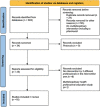Intervention of pharmacist included in multidisciplinary team to reduce adverse drug event: a qualitative systematic review
- PMID: 37649018
- PMCID: PMC10470127
- DOI: 10.1186/s12913-023-09512-6
Intervention of pharmacist included in multidisciplinary team to reduce adverse drug event: a qualitative systematic review
Abstract
Background: Preventable harm in healthcare is a growing public health challenge. In addition to the economic costs of safety failures, adverse drug events (ADE) may lead to complication or even death. Multidisciplinary care team involving a pharmacist appears to be an adequate response to prevention of adverse drug event. This qualitative systematic review aims to identify and describe multidisciplinary planned team-based care involving at least one pharmacist to limit or prevent adverse drug events in the adult patients.
Methods: To determine the type of interprofessional collaboration to prevent adverse drug event in which a pharmacist was involved, we conducted a qualitative systematic review of the literature of randomized controlled trials. Two independent reviewers screened trials in three databases: Medline, Web of Science, ScienceDirect. Prospective studies of at least three different health professionals' interventions, one of whom was a pharmacist in the last five years were included. Two reviewers performed data extraction and quality appraisal independently. We used TIDieR checklist to appraise articles quality.
Results: In total 803 citations were retrieved, 34 were analysed and 16 full-text articles were reviewed. Only 3 studies published an implementation evaluation. More than half of the interventions (62%) targeted elderly patients including 6 whom lived in nursing homes. Studies outcomes were heterogeneous, and we did not perform a statistical analysis of the impact of these interventions. Most teams are composed of a physician/pharmacist/nurse trio (94%; 100%; 88%). Half of the teams were composed of the primary care physician. Other professionals were included such as physical therapists (25%), social worker (19%), occupational therapists (12%), and community health educator (6%). Multidisciplinary medication review was the most common intervention and was generally structured in four steps: data collection and baseline assessment, appraisal report by health professionals, a multidisciplinary medication review meeting and a patient follow-up.
Conclusions: The most common multidisciplinary intervention to prevent ADE in the adult population is the multidisciplinary drug review meeting at least the physician/pharmacist/nurse trio. Interventions target mostly elderly people in nursing homes, although complex chronic patients could benefit from this type of assessment.
Trial registration: PROSPERO registration: CRD42022334685.
Keywords: Adverse drug event; Clinical pharmacist; Drug-related problems; Multidisciplinary team.
© 2023. BioMed Central Ltd., part of Springer Nature.
Conflict of interest statement
The authors declare no competing interests.
Figures
References
-
- Garin N, Sole N, Lucas B, Matas L, Moras D, Rodrigo-Troyano A, Gras-Martin L, Fonts N. Drug related problems in clinical practice: a cross-sectional study on their prevalence, risk factors and associated pharmaceutical interventions. Sci Rep. 2021;11(1):883. 10.1038/s41598-020-80560-2. - PMC - PubMed
-
- Bates DW, Cullen DJ, Laird N, Petersen LA, Small SD, Servi D, Laffel G, Sweitzer BJ, Shea BF, Hallisey R, et al. Incidence of adverse drug events and potential adverse drug events. Implications for prevention. ADE Prevention Study Group. JAMA. 1995;274(1):29–34. - PubMed
-
- Leape LL, Bates DW, Cullen DJ, Cooper J, Demonaco HJ, Gallivan T, Hallisey R, Ives J, Laird N, Laffel G, et al. Systems analysis of adverse drug events. ADE Prevention Study Group. JAMA. 1995;274(1):35–43. - PubMed
-
- Michel P, Minodier C, Lathelize M, Motty-Monnereau C, Dmecq S, Chaleix M. Les évènements indésirables graves associés aux soins observés dans les établissements de santé. Dossiers Solidarité et santé n 17. Paris; 2010:8. https://drees.solidarites-sante.gouv.fr/sites/default/files/2020-10/dss1....
Publication types
MeSH terms
LinkOut - more resources
Full Text Sources
Medical



